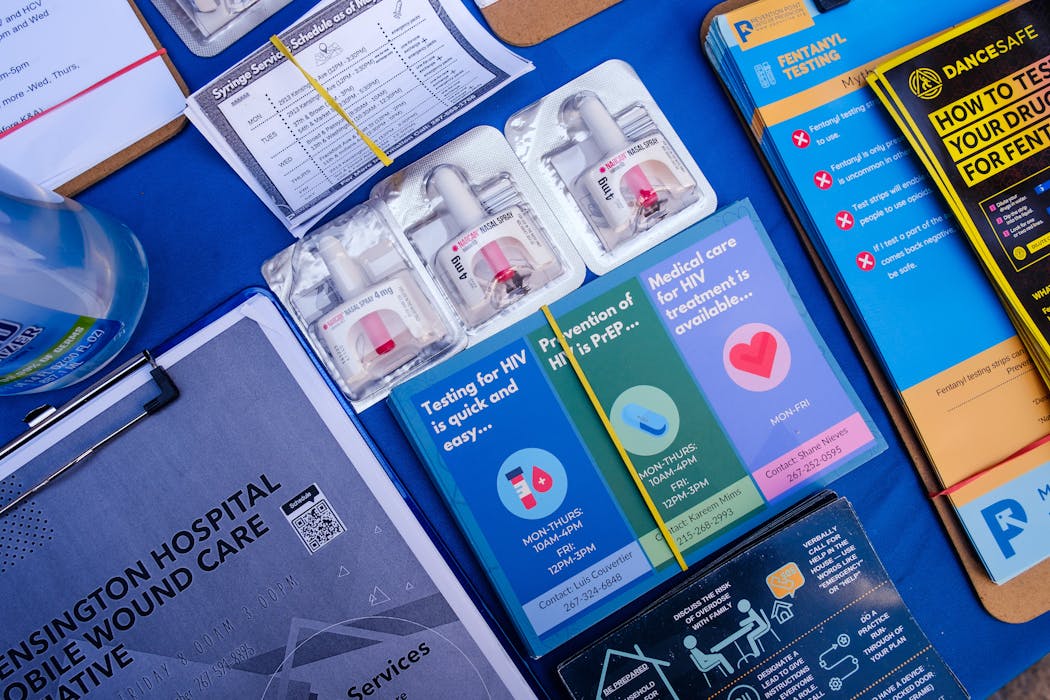Pennsylvania counties face tough choices on spending $2B opioid settlement funds
Local governments have a lot of freedom on how to spend the funds, but there’s also confusion and a feeling of moral responsibility to spend wisely after so many lives have been lost.

In communities across Pennsylvania, local officials are deciding how to spend over US$2 billion dollars from the state’s opioid settlement agreements.
For many, the task is proving promising yet challenging – and raises questions about how to best navigate complex local needs.
Pennsylvania will receive the money over 18 years from lawsuits filed by state attorneys general against opioid manufacturers and distributors. About 70% of these funds will be distributed to county governments, with the remaining funds going to the state legislature and the groups that leveraged the lawsuits.
The amount provided to each county is proportional to the opioid-related harms experienced by the county. Each county government is responsible for developing its own funding strategy for substance use programs, which can focus on things such as prevention, treatment, recovery or harm reduction.
Our research team at Penn State interviewed 72 county officials, health professionals and service providers across six counties in Pennsylvania to understand their early experiences with these funds.
We summarized our findings in a recent article for the peer-reviewed Substance Abuse Treatment, Prevention, and Policy journal. We found that stakeholders view the settlement funds not simply as extra money but as an opportunity to heal – and to test how well local communities can make their own choices about spending.
‘Bags of money’ but limited guidance
Pennsylvania’s distribution strategy was designed to give local governments flexibility. A document called Exhibit E lists the ways that counties can spend the settlement money.
This collaborative document was written as part of the settlement to outline shared guidelines that apply to all the states receiving funds. It lists everything from the types of approved substance use treatments to what qualifies as prevention. In practice, Exhibit E provides diverse opportunities for spending but has also created widespread uncertainty among recipients about which strategies to prioritize.
Some interviewees felt overwhelmed by the logistics of their funding decisions. They understood that the general purpose of the money is to support communities harmed by opioid overprescription. But they lacked clarity on how much time they had to spend it, what the reporting requirements are, and what counts as an eligible activity. For example, some wanted to use the funds to pay administrators for new prevention programs, but administration isn’t included in Exhibit E.
As one local elected official in southeastern Pennsylvania put it, “There’s been a whole lot of stuff that we don’t know – more than we do know. And now we’re running with bags of money through the community and (we’re) not sure how we can spend it, or if we can spend it.”
Many county officials worried about spending the funds too slowly, or on activities that could end up being ineligible or ineffective. Service providers sometimes didn’t know who in their county had the authority to decide where the money went. While they may have wanted to provide recommendations or input, they were unsure how.
A chance to experiment and innovate
Even amid confusion, most of the people we interviewed saw the settlement funding as a unique opportunity.
Exhibit E’s broad guidelines allow for experimentation, and many expressed interest in supporting local needs and implementing projects that they had wanted for a long time. This included things like expanding peer recovery support programs or establishing family support services.
“The guidelines are so varied that it gives those local communities opportunities to look at the menu and find out from community members, ‘How can we help resolve this problem together?’” one local drug and alcohol department employee told us. “It’s a collaborative that really helps the community as a whole get well as a whole. I am a real believer in ‘It takes a village.’”
Several participants emphasized that the flexibility in Exhibit E creates room to revise plans as needs evolve or change. Counties can change their funding priorities each year to adapt.
Several counties have already started issuing small grants to grassroots organizations, recognizing that those closest to people harmed by the opioid crisis often know best what kinds of interventions might work.
One county employee involved in distributing funds in her county shared that her team was “willing to try anything, really, within the bounds.”
“And if it doesn’t work, we can back off,” she added. “But I feel like you don’t know until you try it.”
A moral responsibility to get it right
Although our study focused on policy implementation, participants often framed their responsibilities in moral terms.
Many said they felt a strong obligation to use the funds wisely, given the scale of loss their communities have endured. The Pennsylvania Department of Health reported 4,719 overdose deaths in the state in 2023, and 83% were opioid-related. That number dropped to 3,336 in 2024, mirroring national trends.
One elected official described the funds as “the only hope we can provide families that have lost loved ones to this crisis,” emphasizing that he felt a “real obligation” to make the funds count.
Others echoed that careful, transparent decision-making is part of a broader recovery effort. Beyond abiding by funding guidelines, they felt it was also important to be honest and transparent to community members.
“We don’t want to come out with ‘Pennsylvania wasted its money, or (this) county wasted its money,’” said an addictions researcher.
Still others cautioned that the settlement funds alone cannot repair the full scope of harms caused by the opioid crisis, warning against viewing the settlements as a cure-all.
“There’s not really a monetary value that you can put on these things,” a person who works in the substance use sector told us. “I’m glad that this money’s available, but ultimately for me … it’s a little too late. You know? All my friends are already dead.”
Read more of our stories about Philadelphia and Pennsylvania.
Glenn Sterner receives funding from the Pennsylvania Opioid Misuse and Addiction Abatement Trust, Pennsylvania Department of Drug and Alcohol Programs, Pennsylvania Department of Health, Independence Blue Cross Foundation, Montgomery County Government in Pennsylvania, the Substance Abuse and Mental Health Services Administration, National Institute of Justice, and National Science Foundation.
Brian King, Halie Kampman, Kristina P. Brant, and Maya Weinberg do not work for, consult, own shares in or receive funding from any company or organization that would benefit from this article, and have disclosed no relevant affiliations beyond their academic appointment.
Read These Next
The marketing genius of Spotify Wrapped
Spotify has hit a marketing sweet spot: Users feel compelled to share their annual listening habits…
A hard year for federal workers offers a real-time lesson in resilience
During a year of extraordinary uncertainty, workers built resilient networks within and across boundaries…
Google’s proposed data center in orbit will face issues with space debris in an already crowded orbi
Google’s Project Suncatcher would need sophisticated collision avoidance capabilities to navigate…





